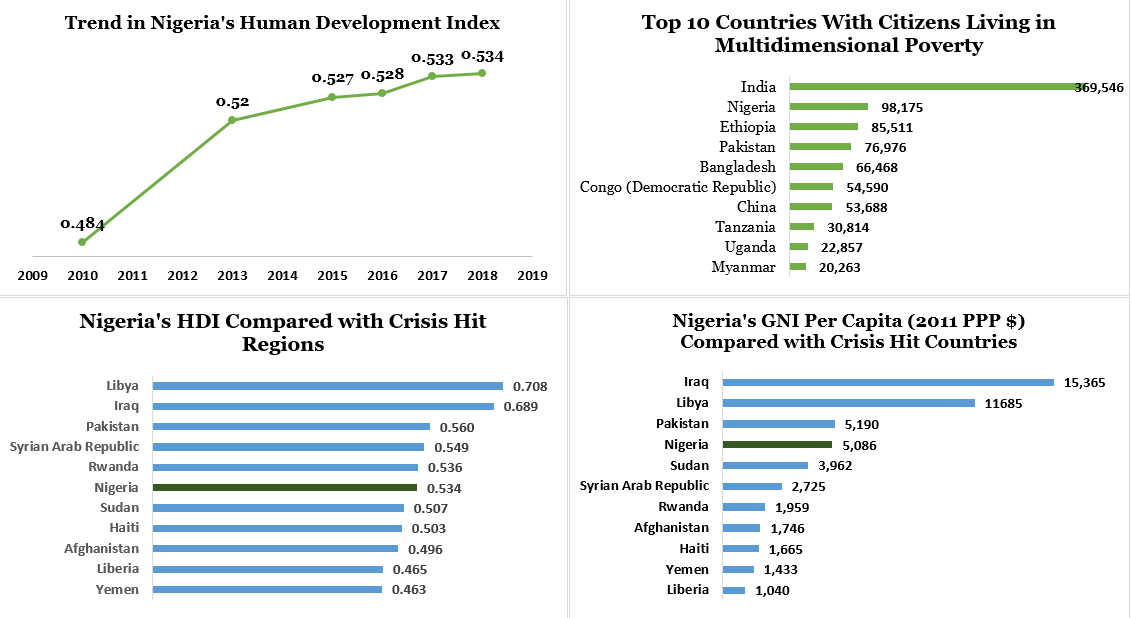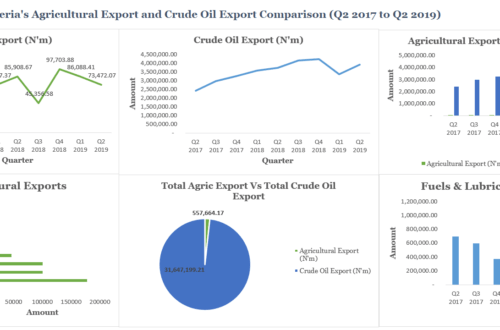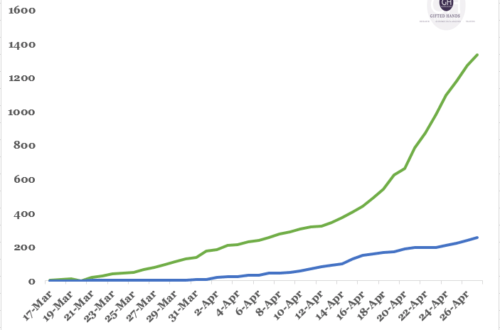
2019 Human Development Report: Nigeria in Focus
Introduction
The Human Development Index (HDI) is a composite index measuring average achievement in three basic dimensions of human development which are knowledge, a long and healthy life as well as a decent standard of living. While knowledge is a measure of Education index, long and healthy life are classified under life expectancy index and standard of living is a measure of the Gross National Income (GNI) index. To know about how these indices are calculated, you can read on it here
The 2019 Human Development Report is titled “Beyond Income, beyond averages, beyond today: Inequalities in human development in the 21st century.” Accordingly, the report explains that in every country many people have little prospect for a better future. Lacking hope, purpose or dignity, they watch from society’s sidelines as they see others pull ahead to ever greater prosperity. Worldwide many have escaped extreme poverty, but even more have neither the opportunities nor the resources to control their lives. Far too often gender, ethnicity or parents’ wealth still determines a person’s place in society.
According to the Human Development Report Office (HDRO), Human Development Index (HDI) classifications are based on HDI fixed cutoff points, which are derived from the quartiles of distributions of the component indicators. The cutoff points are HDI of less than 0.550 for low human development, 0.550–0.699 for medium human development, 0.700–0.799 for high human development and 0.800 or greater for very high human development.
It is on the basis of the above that this research provides analysis into Nigeria’s HDI while comparing it with other countries of the world where it is perceived that they are crisis hit regions. Does Nigeria fair well among these countries? This research article provides answers to that.
Sub-Saharan Africa is the Head Quarters of Poverty in the World
Analysis of the data obtained from the Human Development report shows that 538.206 million citizens in Sub-Saharan Africa live in multi-dimensional poverty and this represents 57.5% of the total population of citizens in the region. Coming next in rank is South Asia as 31% of the citizens in the region live in multi-dimensional poverty and this translates to 542.492 million individuals. Europe and Central Asia have the lowest number of citizens in multi-dimensional poverty as 1.237 million people (1.1% of the population) live in multidimensional poverty.
East Asia and the Pacific however have 110.775 million citizens (5.6% of the population) living in multidimensional poverty as 48.885 million citizens in Arab states live in multi-dimensional poverty while 7.5% (38.067 million) of the entire population living in Latin America and the Caribbean region live in multi-dimensional poverty.

Based on the Data Obtained from the UNDP Human Development Report
The illustration above shows that India has more citizens living in multidimensional poverty than all the other countries of the world. This however constitute 27.9% of its population. The total number of citizens living in multidimensional poverty in India is equivalent to the total number of people living in the same level of poverty in Nigeria, Ethiopia, Pakistan, Bangladesh and Tanzania combined. Of the top 10 countries with citizens living in multidimensional poverty, five are in Africa of which Ethiopia has the highest percentage of its total population living in multidimensional poverty.
For Nigeria, 51.4% of the population live in multidimensional poverty and this translates to 98.175 million citizens. The reason it is called the poverty capital of the world ahead of India and Ethiopia is because the proportion of its citizens living in multidimensional poverty is greater than that of India and in terms of headcount, those living in multidimensional poverty in Nigeria are greater than those in Ethiopia.
Trend in Nigeria’s Human Development Index
Based on the data obtained from the UNDP, Nigeria’s HDI has continued to rise over time (2010 to 2018) even though it is low in rank. The country went from HDI of 0.484 in 2010 to 0.534 in 2018 even though its rank was 158 out of 189 countries. This shows there is still need for improvement as the country is classified under countries with low human development index.

Based on the Data Obtained from the UNDP Human Development Report
Data from the report also shows that 32.7% of Nigeria’s Gross National Income is held by the richest 10% while 15.1% of the country’s income is held by the poorest 40%. The Gini Coefficient which is a measure of income inequality therefore averaged 43.0 between 2010 and 2017.
Nigeria’s HDI Compared with Crisis Hit Countries
With HDI value of 0.801, Seychelles ranks number 1 in Africa and 62 in the world in terms of Human Development and it has a life expectancy at birth of 73.3 years. Seychelles also has the highest Gross National Income per capita in Africa at $25,077 Followed closely is Mauritius which ranks 66 in the world (automatically making it the second highest ranking African country) with index value of 0.796 and life expectancy at birth of 74.9 years. Algeria ranks third in Africa and 82nd in the world with an index value of 0.759 and 76.7 years life expectancy at birth.

Based on the Data Obtained from the UNDP Human Development Report
Rwanda (characterized by Genocide years before now), crisis hit Syria, Pakistan, Iraq and Libya all rank above Nigeria in terms of Human development. While Nigeria is ranked 158th (out of 189 countries) in the world, Libya is ranked 110th, Iraq is ranked 120th, Pakistan ranked 152nd, and Syria as well as Rwanda are ranked 154th and 157th respectively. Of the countries above Nigeria, only Rwanda is in the same category of Low Human Development with Nigeria.

Based on the Data Obtained from the UNDP Human Development Report
The data above shows that Nigeria fairs well above Sudan, Syria, Rwanda, Afghanistan, Haiti, Yemen and Liberia when the gross income of the country is shared equally among its population.

In terms of Gender inequality index, the higher the index, the higher the gender inequality in a country while the lower the index, the lower the gender inequality in the particular country. Based on the gender inequality index, Libya has the lowest gender bias among the countries under review while Yemen has the highest inequality index based on gender.
Life expectancy at birth is lowest in Nigeria among the countries reviewed while it is highest in Libya as the life expectancy of children born in Libya is 72.7 years.
Conclusion
Despite Nigeria being a leader in Africa in terms of GDP and in terms of population, it does not translate to the citizens having a better quality of life even when compared with crisis hit regions of the world. It shows resources are not being effectively used to the optimum benefit of the growing population.
Libya ranking above Nigeria in all the human development index used in this research work explains why Nigerians illegally tend to migrate to Libya. This shows the citizens of Nigeria perceive Libya to offer them better opportunities than Nigeria and the data and analysis above explains that.
Download the 2019 Human Development Report here
You can provide your comments in the space provided below. Additionally and should you need data backed research and analysis for your business or research needs, send a mail to info@giftedanalysts.com





6 Comments
Ridwan Aliu
That’s a great article you wrote but I believe there’s a contradiction in these statements. One emphasized that India’s total population living in multidimensional poverty is equivalent to the countries mentioned while the other statements says otherwise.
“The total number of citizens living in multidimensional poverty in India is equivalent to the total number of people living in the same level of poverty in Nigeria, Ethiopia, Pakistan, Bangladesh and Tanzania combined. ”
“The reason it (Nigeria) is called the poverty capital of the world ahead of India and Ethiopia is because the proportion of its citizens living in multidimensional poverty is greater than that of India”.
Abdulazeez Kuranga
Thank you Ridwan Aliu.
India still leads in terms of poverty headcount. However, the proportion of those living in the poverty as a percentage of the population is low when compared to Nigeria. Also, while those entering into the poverty gap in India is decreasing, that of Nigeria and Ethiopia is increasing. Every minute, six Nigerians enter into the poverty gap according to the World Poverty clock.
Overall, the statements in the article are just possible justifications on why Nigeria is referred to as the poverty capital of the world. I believe the clarifications here too should be sufficient.
Thank you once again for your feedback. It is very much appreciated.
Ridwan Aliu
That’s clear enough. The justification here is “the number of people entering poverty in India is at a decreasing rate compare to Nigeria and Ethiopia”.
I’d have loved to work with you. Such a brilliant soul.
Ridwan Aliu
If you’re looking for a freelance researcher on Economic issues. I’m available too.
Tive Denedo
Great analysis but can you take a look at this sentence & edit. “Libya ranking above Nigeria in all the human development index used in this research work explains why Nigerians illegally tend to migrate to Nigeria.”
Abdulazeez Kuranga
Thank you very much for the feedback Denedo. It has been looked into and edited.